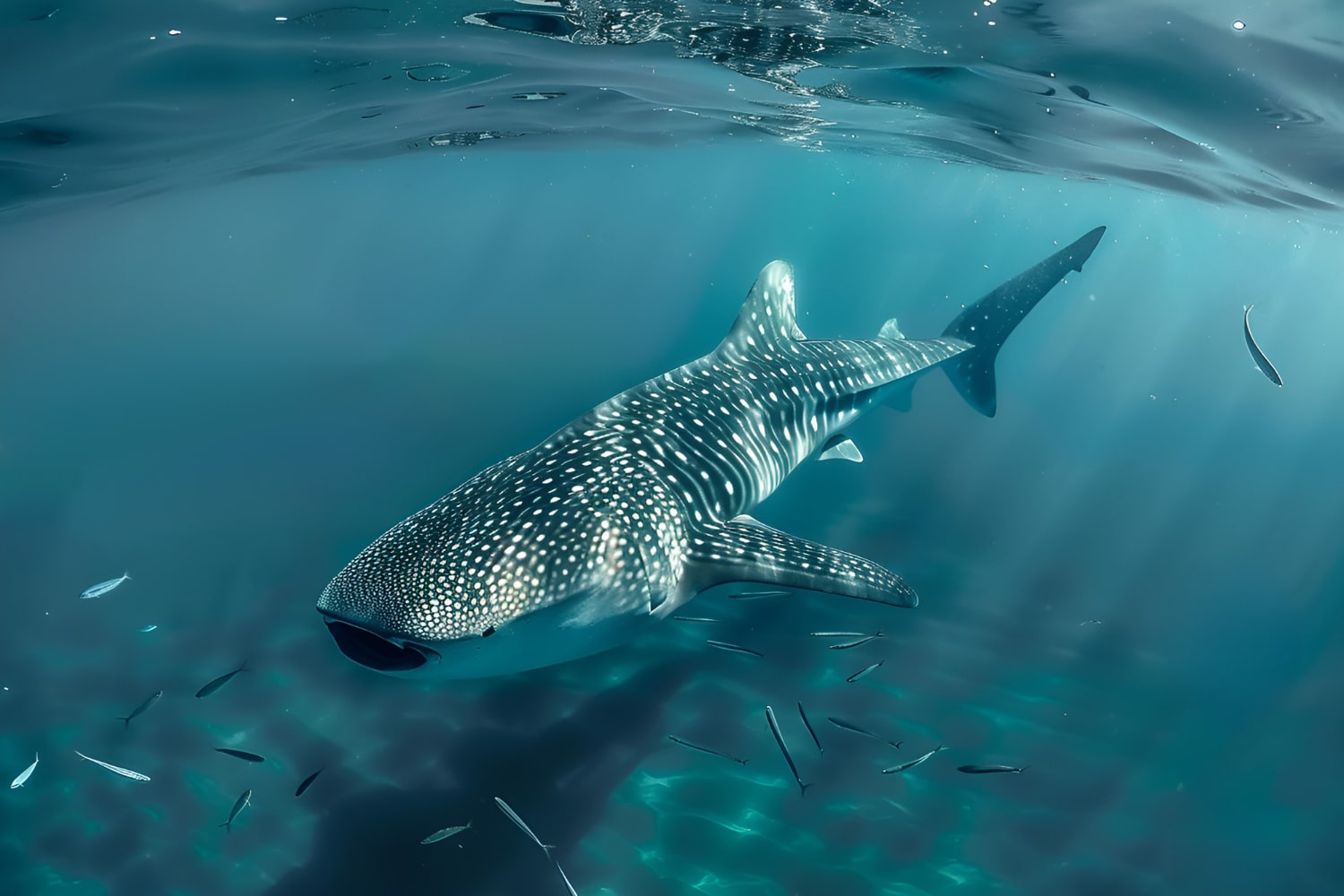The whale shark is one of the most extraordinary marine creatures, combining enormous size with a gentle nature. Although it belongs to the shark family, its behavior, diet, and lifestyle are very different from those of typical predators. This massive ocean dweller fascinates scientists and nature lovers around the world. Below is a collection of fascinating and surprising facts about whale sharks you may not have known. Get ready to discover the mysterious world of one of the ocean’s most peaceful giants.
- The whale shark is the largest fish on Earth. Adult individuals can reach up to 18 meters in length and weigh more than 20 tons. Despite their massive size, they feed exclusively on small organisms such as plankton and tiny fish. Their feeding habits resemble those of whales, which is why they were given this name.
- Despite their size, whale sharks are completely harmless to humans. They show no aggression and often allow divers to swim close by. Their mouth is large, but the teeth are tiny and not designed for biting or hunting. Instead, they filter water to collect food particles.
- Each whale shark has a unique pattern of white spots and stripes on its skin. This pattern is as individual as a human fingerprint and allows scientists to identify different sharks. Researchers use photographs and special recognition software to monitor these patterns during observations. This helps track their migration routes across the oceans.
- Whale sharks feed through a process called filter feeding. They open their wide mouths and pass water through filter pads that trap microscopic food. In one hour, a whale shark can filter up to six tons of water. This method allows them to thrive even in areas where food is scarce.
- Whale sharks are believed to live more than 70 years. Some sources suggest they might live up to 100 years, but this has not yet been scientifically confirmed. Due to their slow growth and late maturity, their population is vulnerable to decline. Protecting them is crucial for maintaining marine biodiversity.
- Whale sharks inhabit warm tropical waters around the world. They are most commonly found near the coasts of the Philippines, Australia, Mexico, Indonesia, and the Maldives. They are migratory and travel great distances in search of food. The exact patterns of their migrations are still not fully understood by science.
- Despite their massive bodies, whale sharks have very small eyes located on the sides of their heads. They rely more on smell and skin sensitivity than on vision. Their skin can detect the slightest changes in the surrounding water. This helps them navigate in the dark or in murky conditions.
- Whale sharks have extremely thick skin, up to 10 centimeters in some areas. This thick layer protects them from injuries and parasites. However, it can still be damaged by boat propellers or careless human contact. That’s why tourism involving whale sharks must be strictly regulated.
- A whale shark’s mouth contains over 3,000 tiny teeth, but they are not used for chewing. The teeth are arranged in several rows and are considered vestigial, left over from their evolutionary past. The entire feeding process happens without actively using their teeth. This further proves their gentle nature.
- Whale sharks reproduce through ovoviviparity. Embryos develop inside eggs within the mother’s body, and the young are born live. A single female can give birth to up to 300 pups at one time. Unfortunately, many of the young do not survive, which slows population growth.
- The whale shark has the largest mouth of any fish. It can open its jaws up to 1.5 meters wide. This allows it to take in large volumes of water while feeding. Unlike many sharks, its mouth is positioned at the front of the head.
- These animals play a vital ecological role in marine ecosystems. They help regulate plankton populations and prevent overgrowth of small fish. They are also considered indicators of ocean health. Their presence or absence signals changes in the marine environment.
- Despite their weight, whale sharks can rise to the water’s surface and even leap out of it. These jumps are rare but have been documented by researchers. It is believed that breaching may help them shed parasites or serve as a form of communication. The behavior is still being studied.
- Although whale sharks are not predators, they can fall victim to larger animals. Juveniles may be attacked by orcas, large sharks, or humans. The biggest threats to whale sharks are poaching, ocean pollution, and collisions with boats. As a result, the International Union for Conservation of Nature has listed them as a vulnerable species.
- In many cultures, whale sharks are seen as symbols of harmony, strength, and longevity. In the Philippines, they are respected as spiritual guardians of the sea. In some regions, their images are painted on boats or featured in traditional art. This reflects the deep connection between people and nature.
- Whale sharks are capable of diving to depths of over 1,000 meters. These deep dives usually occur at night or during long migrations. Scientists use tracking tags to study their movements. Much about their deep-sea journeys remains unknown.
The whale shark is a true wonder of nature, combining immense size, a peaceful temperament, and unique adaptations to life in the ocean. Its behavior, ecological importance, and impressive appearance inspire admiration in scientists and nature enthusiasts alike. These incredible facts about whale sharks help us better understand the need for their conservation. The more we learn about these giants, the deeper our appreciation grows for their fascinating world.





